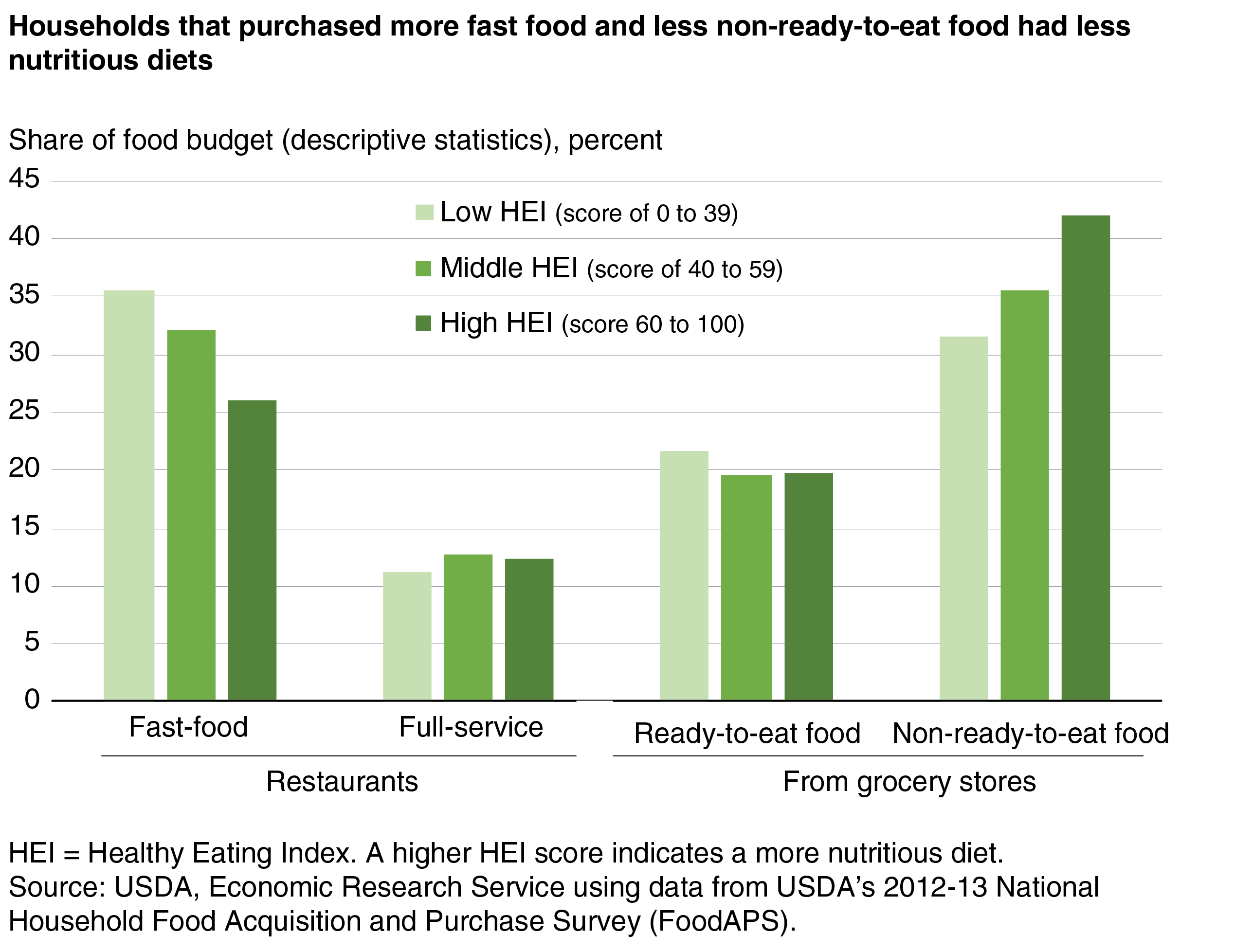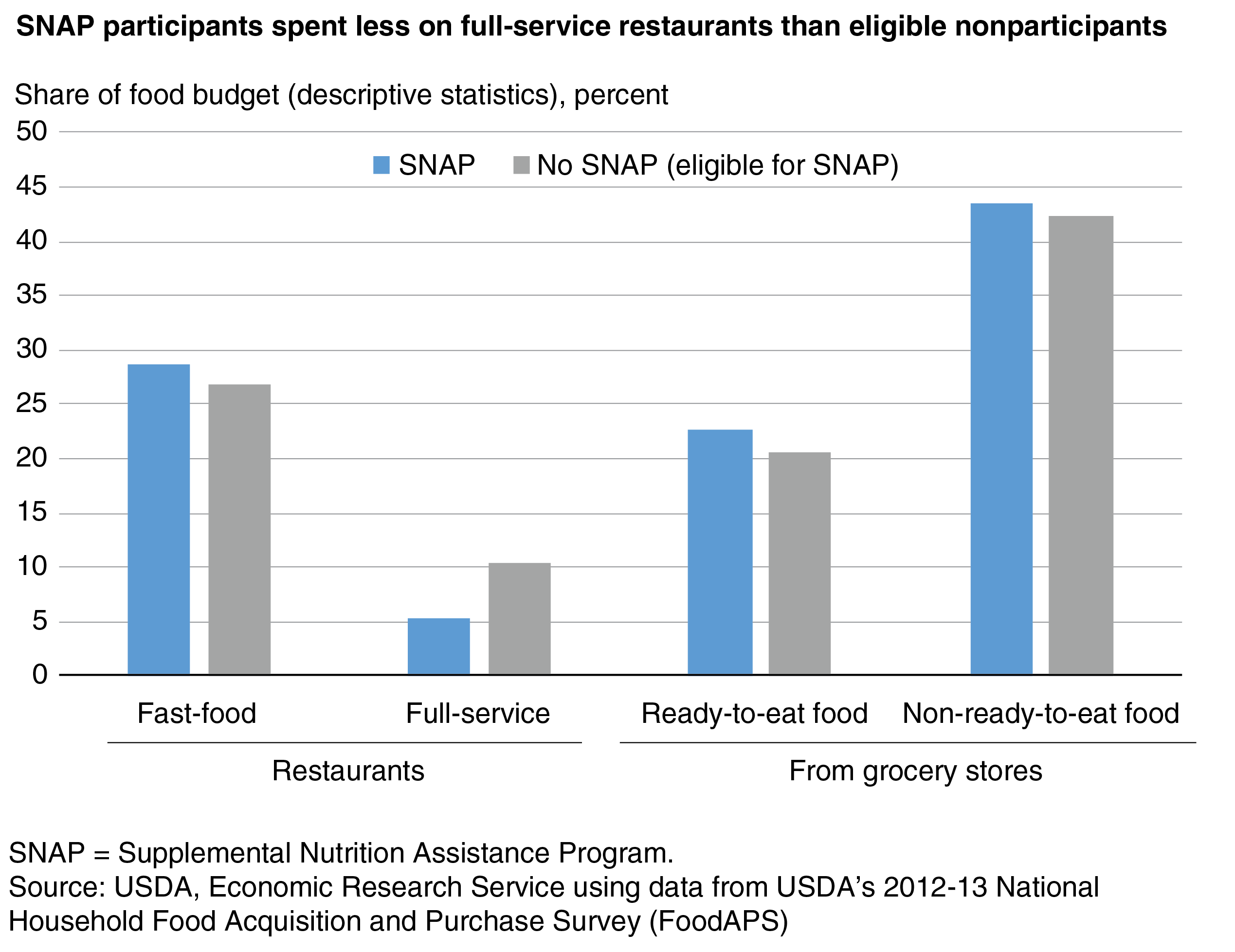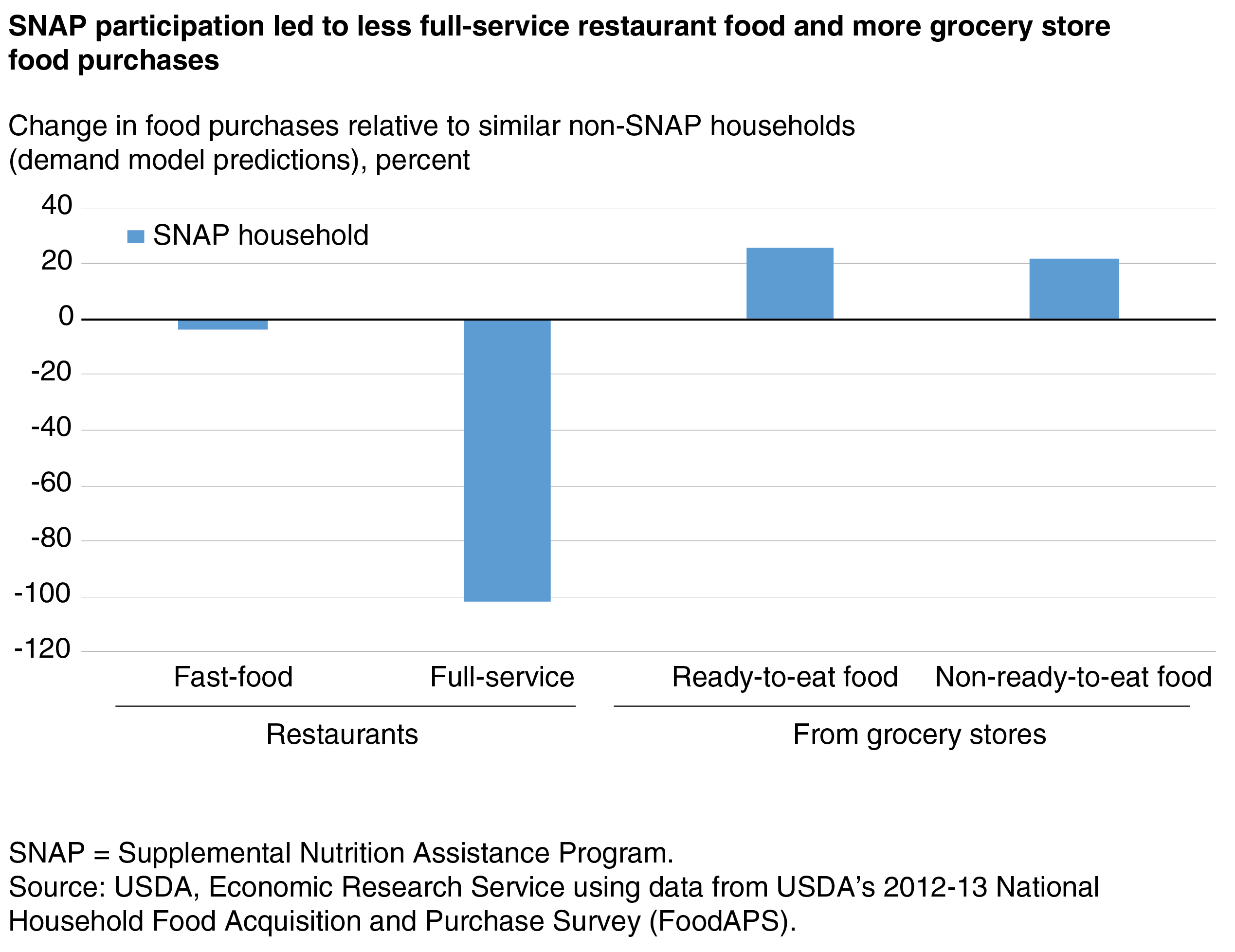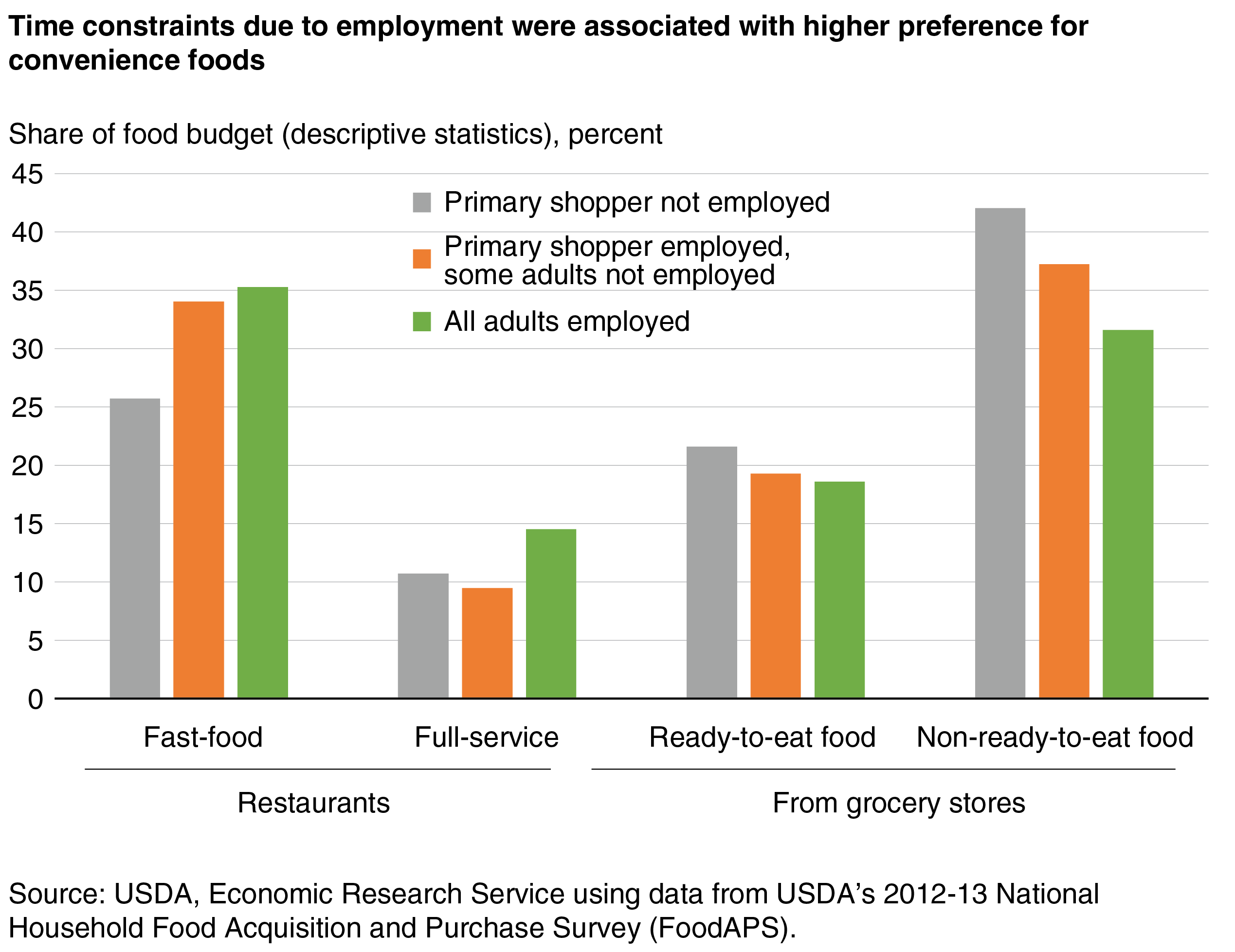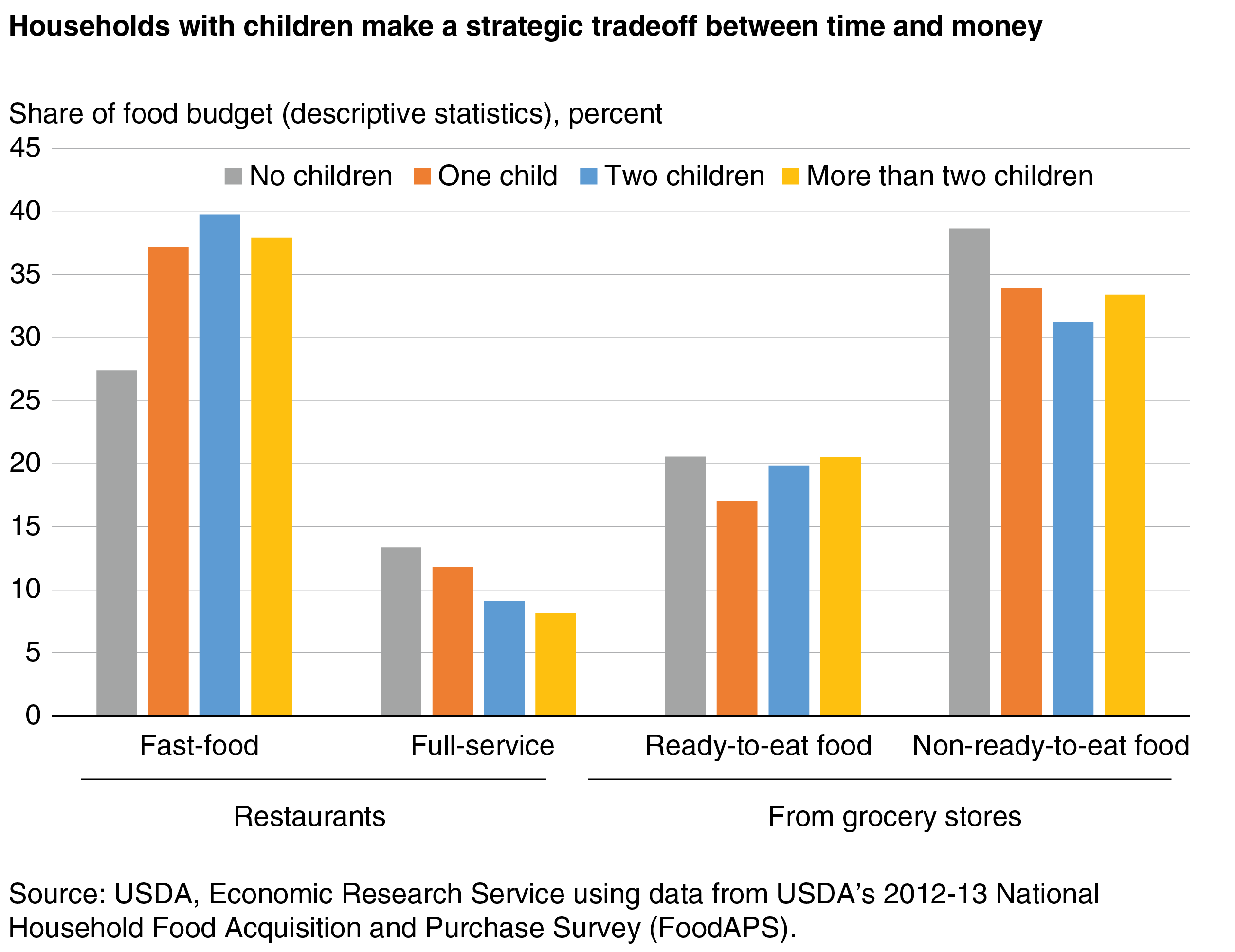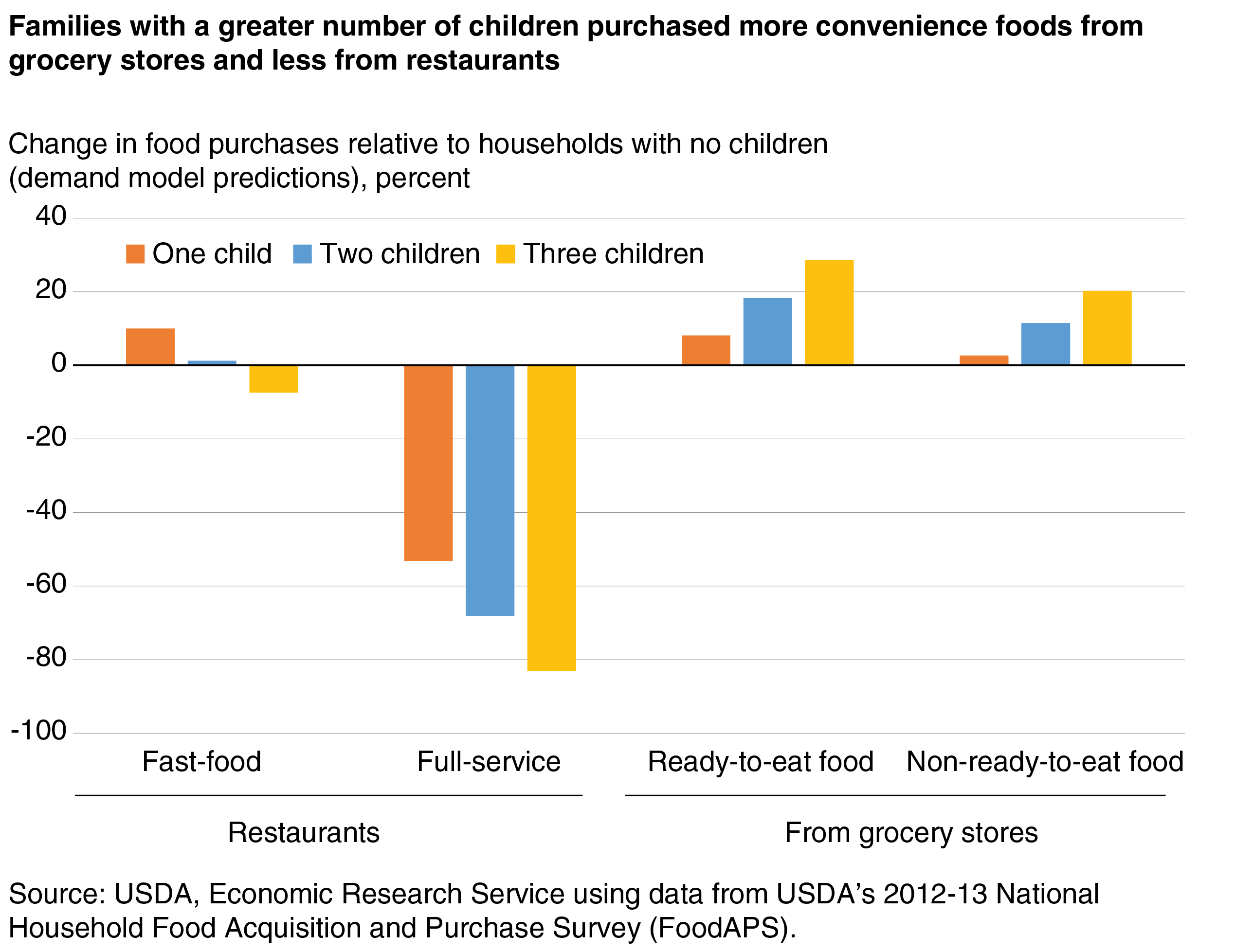
Higher Incomes and Greater Time Constraints Lead to Purchasing More Convenience Foods
- by Ilya Rahkovsky and Young Jo
- 6/27/2018
Highlights
- Households with higher incomes spend more at full-service restaurants and less at fast-food restaurants than lower income households.
- Time constraints due to employment lead to more spending at full-service restaurants.
- SNAP households spend less at full-service restaurants and more on grocery store foods than income-eligible nonparticipants.
A time-pressed consumer is likely to look for short cuts throughout the day. Picking up meals at a drive-thru or prepared dishes from the grocery store deli section saves the time spent shopping for ingredients, cooking the meal, and cleaning up afterward. However, food that is more convenient, or less time-consuming, tends also to be more expensive—an already prepared rotisserie chicken from the deli section, for example, costs more than a similar-sized fresh whole chicken from the meat case. But more Americans today appear to value convenience over money when it comes to their food purchases.
In 1996, consumers spent 61 percent of their food budgets on grocery foods and 39 percent on food consumed away from home, primarily in restaurants. By 2016, consumers spent just 56 percent of their food budgets on grocery foods. Previous ERS studies show that, on average, restaurant foods generally have lower nutritional quality and higher calories than grocery store foods. Prepared foods from grocery stores can also be higher in calories, fats, and sodium than home-prepared dishes. Increased spending on convenience foods—either from restaurants or grocery stores—can imply worsening diet quality and health outcomes. Understanding the factors affecting demand for convenience foods has implications for public health.
Using USDA’s 2012-13 National Household Food Acquisition and Purchase Survey (FoodAPS), ERS researchers examined the food spending habits of nationally representative households to understand the factors affecting demand for convenience foods. They found that higher incomes and greater time constraints were associated with greater purchases from restaurants and fewer purchases from grocery stores. In addition, the more money consumers spent on food that was more convenient, the poorer their diet quality.
Convenience Foods Are More Expensive and Less Healthy Than Non-Convenience Foods
ERS researchers used FoodAPS data to divide a household’s food purchases into four groups:
- Purchases from fast-food restaurants—places where consumers pay for their food before they eat, such as burger places, sandwich or coffee shops, and bakeries.
- Purchases from full-service restaurants—places where the server brings food to the table and consumers pay for their food after they have eaten.
- Purchases of ready-to-eat foods from grocery stores—these are foods that do not need to be heated, such as milk, orange juice, and other beverages; fresh fruit; breakfast cereals; cooked deli meats, cheeses, and salads; yogurt; peanut butter and other spreads; and foods that only need to be heated, such as frozen meals and canned soups.
- Purchases of non-ready-to-eat foods from grocery stores—these are foods that generally need to be cooked, such as raw meats, seafood, dry beans, pasta, eggs, oils, and other similar ingredient foods.
Convenience comes at a cost. Restaurant foods are generally more expensive than foods bought from grocery stores not only in terms of dollars but also calories. The cost per calorie is usually higher for restaurant foods. For example, even though FoodAPS households spent 31 percent of their food budgets on fast food, fast food only made up 14 percent of their total calories purchased. In contrast, households spent a lower share of their food budgets on ready-to-eat food (20 percent), but these foods accounted for 33 percent of their total calories purchased. Households spent 37 percent of their food budgets on non-ready-to-eat foods and obtained 48 percent of their purchased calories from those foods.
Increasing consumption of restaurant food has often been cited as a likely reason behind poor diet quality and high obesity rates in the United States. To examine if food spending is related to diet quality, the ERS researchers used the Healthy Eating Index (HEI) to assess the nutritional quality of foods purchased by FoodAPS households. The HEI measures how well a set of foods per 1,000 calories conforms to the recommendations in the Dietary Guidelines for Americans. The index ranges from 0 (the least nutritious) to 100 (the most nutritious). The average HEI of foods purchased by FoodAPS households was 50.
A lower HEI was associated with higher spending on fast food and lower spending on non-ready-to-eat foods. For example, households with HEI below 40 spent 36 percent of their food budgets on fast food and 32 percent on non-ready-to-eat foods. In contrast, households with HEI above 60 spent 26 percent of their food budgets on fast food and 42 percent on non-ready-to-eat foods.
Larger Food Budget Allows for More Convenience Food Purchases
Factors determining demand for convenience foods range from income, education, and the number of children in a household, to the distance to food stores and restaurants. A consumer demand model sheds light on the relative importance of each factor while controlling for all of the other factors. The model predicts that the most important factors determining the demand for convenience foods are financial factors (income, participation in food assistance programs, and prices) and time-cost factors (employment and the number of children). Understanding the relative importance of a factor is important since many of the factors can be related. For example, consumers who are employed are also more likely to have higher incomes than those who are not employed. In such cases, it is difficult to disentangle how employment affects demand for convenience foods separately from income. The demand analysis allows researchers to estimate the effects of a change in a given factor (e.g., employment) among otherwise similar households.
Income is an important determinant of food demand. It is well known that, on average, higher income consumers purchase more restaurants foods. The findings from a consumer demand analysis demonstrate a more complex spending pattern when the researchers simulate a change of income among otherwise similar households. Compared to the middle-income households (monthly household income between $2,000 and $5,000), the otherwise similar higher income households purchased 28 percent more full-service restaurant food, 29 percent less fast food, and 11 percent less ready-to-eat food. On the other hand, similar low-income households purchased 33 percent less full-service restaurant food, 29 percent more fast food, and 11 percent more ready-to-eat food than middle-income households. In short, lower incomes lead households to purchase cheaper convenience foods, such as fast food or ready-to-eat foods, while higher incomes result in purchasing more expensive convenience foods such as full-service restaurant foods.
Because USDA’s Supplemental Nutrition Assistance Program (SNAP) increases participants’ budgets for grocery store foods, the researchers found that SNAP participation decreased spending at restaurants. Among SNAP participants, for example, the food budget share for full-service restaurants (5 percent) was half that of income-eligible households who are not receiving SNAP benefits (10 percent).
Consistent with these findings from descriptive statistics, the demand analysis indicates that income-eligible non-SNAP households purchase almost twice as much full-service restaurant foods as SNAP households. In addition, the demand model shows that SNAP participation led to an increase in purchases of both ready-to-eat foods by 26 percent and non-ready-to-eat foods by 21 percent.
Greater Time Constraints From Employment and Childcare Lead to More Convenience Food Purchases
Greater time constraints lead to a greater demand for convenience foods. However, the source of the time constraints—employment or childcare—also matters when it comes to the type of convenience foods that households purchase. Households with a greater number of employed adults are more time constrained, but also have higher incomes. Hence, the food spending patterns of households where all adults are employed resemble those of high-income households, while the spending patterns of households with an unemployed primary shopper resemble those of low-income households.
Households constrained by employment spent more on restaurant food and less on grocery store food. Households where all adults were employed spent about half of their food budget at restaurants, whereas households where a primary shopper was unemployed spent only 36 percent. In particular, households where all adults were employed spent 4 percentage points more on full-service restaurant food and 9 percentage points more on fast food than those where a primary shopper was unemployed.
The share of the food budget spent on non-ready-to-eat foods presents a consistent picture of households making a tradeoff between time and money. Households where all adults were employed spent 10 percentage points less of their food budgets on non-ready-to-eat foods compared to households where a primary shopper was not employed. In other words, households that are time constrained from employment purchased more expensive, yet convenient, foods over cheaper foods that take more time to prepare.
The findings from the demand analysis are consistent with those from descriptive statistics. The demand analysis indicates that employment of all adults in a household reduced the purchases of ready-to-eat foods by 12 percent and increased the purchases of full-service restaurant foods by 72 percent relative to households where no adults were employed.
Childcare-related time constraints present a more complicated picture than time constraints from employment. Not surprisingly, households with children spent more on restaurant food and less on grocery store food than households without children. For example, households with two children spent almost half of their food budget on restaurant food, while households without children spent only 41 percent. Households with children, however, spent less on full-service restaurants than those without children regardless of the number of children, possibly because of the relative scarcity of child friendly full-service restaurants.
As the number of children increases, the monetary cost of eating out seems to outweigh the benefits from the time savings, especially once households have more than two children. For example, households without children spent 27 percent of their food budget on fast food. This share increased by 10 percentage points for households with one child and by 13 percentage points for households with two children. However, the share spent on fast food did not increase after two children and showed a statistically insignificant decrease of 2 percentage points relative to the households with two children.
Similarly, the spending shares on non-ready-to-eat foods were 5 and 8 percentage points lower for households with one child and two children, respectively, compared to those without children. However, the share increased by 2 percentage points for households with more than two children, compared with those with just two children. This last difference is not statistically significant, but it suggests that larger families eat at home more often, since the monetary cost of eating out likely outweighs the benefit of time savings.
The results from the demand analysis are largely consistent with those from descriptive statistics. The model predicts the change in food purchases experienced by one-child, two-child, and three-child households relative to similar households with no children. If a one-child household is expected to buy 10 percent more fast-food meals than a similar household with no children, the three-child household is expected to buy 7 percent less. Fast food is the only food that shows a different dynamic for households with few and many children. As the number of children increases, purchases of full-service restaurant foods consistently decrease, and purchases of supermarket foods consistently increase.
As Americans become more pressed for time, they are choosing to buy more convenience food, whether it is restaurant food or ready-to-eat grocery store food. Convenience foods are often more expensive than non-ready-to-eat ingredient foods, and some convenience foods can be more dense in calories and less dense in healthy nutrients. Consumers may want to be cautious about the potential impacts of these time-saving foods on their diet and body weight.
This article is drawn from:
- Rahkovsky, I., Jo, Y. & Carlson, A. (2018). Consumers Balance Time and Money in Purchasing Convenience Foods. U.S. Department of Agriculture, Economic Research Service. ERR-251.


